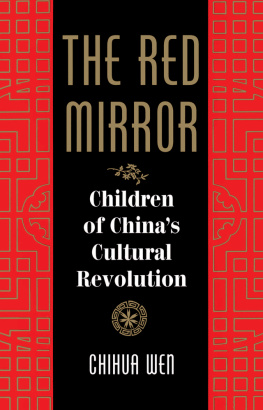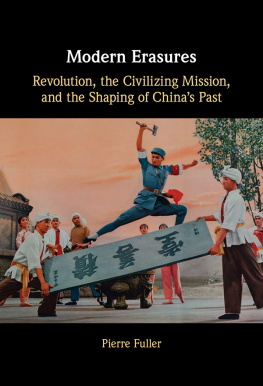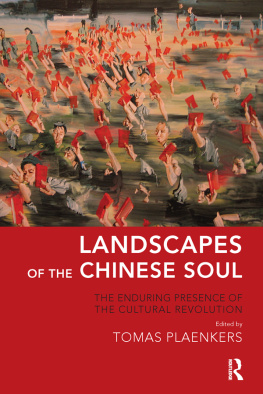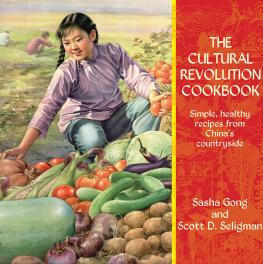TEN YEARS OF TURBULENCE
A PUBLICATION OF THE GRADUATE INSTITUTE
OF INTERNATIONAL STUDIES,
GENEVA
Also published in this series:
The United States and the Politicization of the World Bank
Bartram S. Brown
Trade Negotiations in the OECD
David J. Blair
World Financial Markets after 1992
Hans Genberg and Alexander K. Swoboda
Succession Between International Organizations
Patrick R. Myers
TEN YEARS OF
TURBULENCE
The Chinese Cultural Revolution
Barbara Barnouin
Yu Changgen
First published in 1993 by
Kegan Paul International
This edition first published in 2010 by
Routledge
2 Park Square, Milton Park, Abingdon, Oxon, OX14 4RN
Simultaneously published in the USA and Canada
by Routledge
270 Madison Avenue, New York, NY 10016
Routledge is an imprint of the Taylor & Francis Group, an informa business
The Graduate Institute of International Studies 1993
All rights reserved. No part of this book may be reprinted or reproduced or
utilised in any form or by any electronic, mechanical, or other means, now
known or hereafter invented, including photocopying and recording, or in
any information storage or retrieval system, without permission in writing
from the publishers.
British Library Cataloguing in Publication Data
A catalogue record for this book is available from the British Library
ISBN 10: 0-7103-0458-7 (hbk)
ISBN 13: 978-0-7103-0458-2 (hbk)
Publishers Note
The publisher has gone to great lengths to ensure the quality of this reprint
but points out that some imperfections in the original copies may be
apparent. The publisher has made every effort to contact original copyright
holders and would welcome correspondence from those they have been
unable to trace.
CONTENTS
Introduction
The Cultural Revolution (CR) was undoubtedly one of the most tumultuous and dramatic periods of Chinas modern history. It was marked by violence, factionalism and economic disruptions. The cataclysm it created had traumatic effects on the majority of the Chinese people, both in their private and professional lives.
A myriad of literature about this period has been published in the West and in China. Without denigrating the value of these contributions, we believe that most of the Western books are often theoretical, and written from a distance; Chinese writings which we will discuss in more detail in the Note on Chinese Sources are, with a few exceptions, fragmented and inspired by official policy. It is one of the objectives of this study to integrate Western and after careful evaluation Chinese literature. The evaluation has been substantiated by extensive informal conversations with people who were politically active during the Cultural Revolution, and by the experiences of the Chinese co-author who lived through this period with a critical mind.
In this study, we emphasise the primordial role of Mao Zedong in instigating and prolonging the Cultural Revolution. It was a phenomenon directly linked to Maos theoretical, political and social perceptions, his status among the Chinese leadership, and his personality. It is our hypothesis that, without him, the CR would not have occurred.
Maos motivations in instigating the CR were both ideological and political, in varying degrees of importance. On the ideological front, he perceived a constant danger of capitalist restoration. With his paranoic sense of grandeur Mao used the CR as a means to eliminate those he considered, rightly or wrongly, to be his political adversaries. His overwhelming power status allowed him to impose his political designs among his peers. But the CR, once unleashed, developed into a phenomenon which he was unable to control completely, opening the way for violent factional strifes and power struggles.
Factionalism, which penetrated the entire Chinese society and revealed a deep cleavage among the Chinese people, was perhaps the most salient feature of the CR. It developed at two levels. At grassroot level the country was divided into conservative and radical factions with the former defending the party apparatus Mao had set out to destroy, and the latter participating in the destructive process which Mao had proclaimed at least temporarily as the principal prerogative of the CR. Both factions claimed ideological allegiance to Mao, but, in fact, ideology played a relatively small role in their rivalries in comparison to personal inclinations and conflicts, which determined the integration of people into one faction or another. But another important factor which determined factionalism was manipulation by the leadership, primarily by Mao himself.
The second level of factionalism occurred at leadership level. A major purpose of this book is to show that Mao himself was not involved in power struggles, but was, in fact, a figure towering above the rest of the leadership and, as such, the only person able to dominate the political situation to a degree which allowed him to manipulate other leaders as well as the population.
Among the leaders below him, conflicting interests developed and shifted over the period of the CR. Throughout the entire period, Mao acted as a ruler who followed the principle of divide and rule, never allowing any faction to gain uncontested power, while vicious power struggles and personal bickering often dominated the activities of the leadership below his level.
Origins
The CR engulfed the entire country in a destructive political movement which shook the very foundation of Party and state, and which persecuted millions of people from all strata of the Chinese society. In the moderate language of the 1981 Resolution on Party History, it brought about the most serious setback and heaviest losses suffered by the party, the state and the people since the founding of the Peoples Republic. If this was the case, where did Maos ideas originate and why were they so vital that they unleashed such a powerful movement as the Cultural Revolution? The Resolution does not offer an answer to this question. It also papers over the cooperation the Chinese leadership had willingly extended to Mao and his policies and thus offers no explanation why the leadership supported Maos policies, often to the point of self-destruction.
Part of the answer lies with the very nature of communist parties and socialist systems which promote the establishment of a ruling caste headed by a supreme leader with vast powers of decision making and immense political authority in his hands. History is replete with such examples. In China, with its millenarian tradition of autocratic imperial rule, this phenomenon was particularly rampant. Mao, the revolutionary leader, overcame numerous obstacles on the way to final victory of his policies. The success of his strategies and of his policies leading to Chinas unification contributed significantly to the development of his charisma. Mao was viewed as the principal architect of the Chinese revolution which changed the face of the country. These achievements established him in a position comparable only to Chinas most powerful emperors.
Maos decision to launch the CR can be attributed to a number of factors. The first was the radicalisation of his thinking partly due to societal developments since the late 1950s; the second was his charismatic leadership and the cult of personality; and the third was Maos alienation from other national leaders who, although they basically supported him, were unable fully to conform to his ideas in the implementation of policies.







